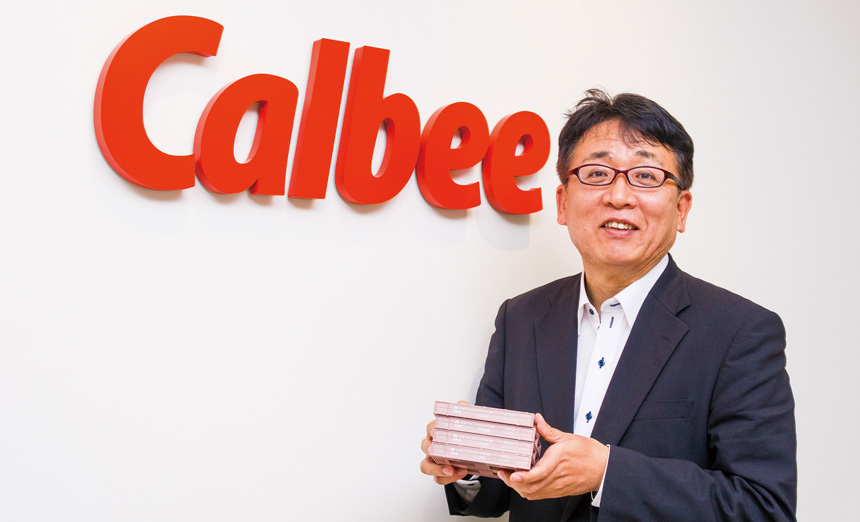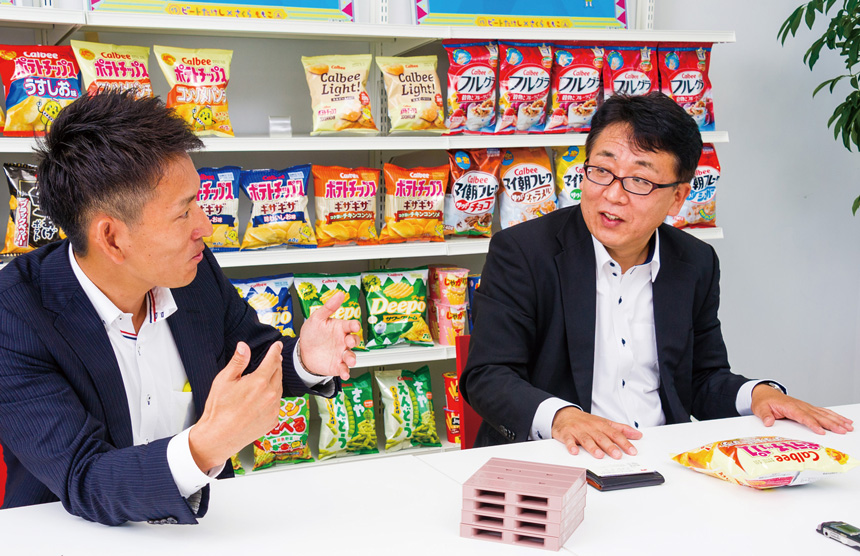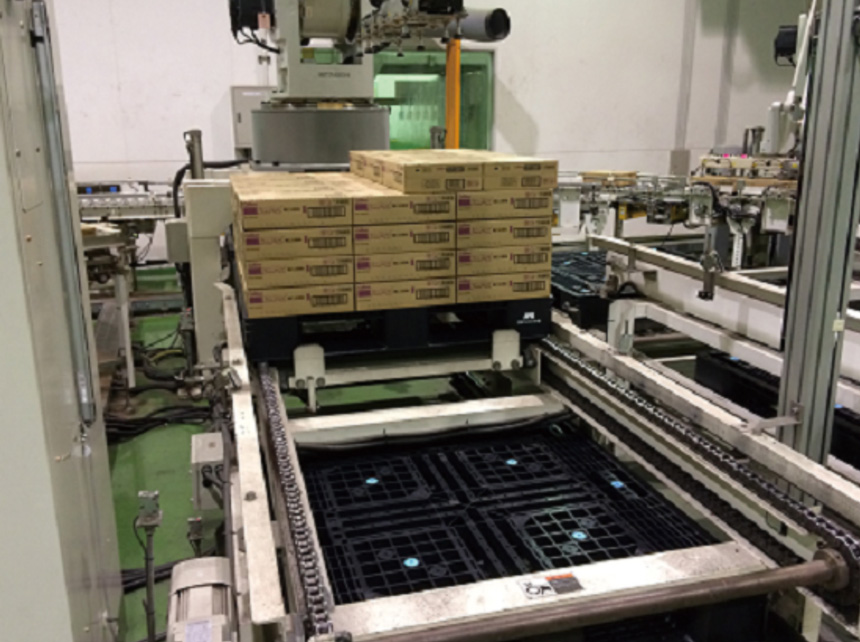Calbee, Inc.
Creating an environment that is optimized for the driver. Pallets are part of the solution
* The information is used from the time of publication in August 2015, which has been partially updated in September 2020.
* Company names and product names mentioned are registered trademarks or trademarks of their respective companies.
Calbee, Inc. has launched many popular and long-selling products over its 70 year history. The company was one of the earliest manufacturers in the confectionery industry to promote palletization, and in January 2015 they introduced rental pallets in its Kyoto plant. We asked Mr. Matsumoto, Executive Officer, General Manager of SCM Division, Operating Company, about his targets and future policy direction in logistics.

Mr. Hisashi Matsumoto,
Executive Officer, General Manager of SCM Division, Operating Company, Calbee, Inc.
and President and CEO of Calbee Logistics, Inc.
Multiple best-selling products, producing 2 billion bags of confectionery and food annually
Calbee, Inc. is a confectionery and food manufacturer founded in 1949. With many long-selling products such as "Kappa Ebisen" (launched 55 years ago), "Calbee's Potato Chips" (44 years ago), and "Jagarico" (now in its 24th year). Recently, a product called "Frugra" has become a popular breakfast food.
On average, about 400 items are manufactured and 2 billion bags are produced each year. Products are generally purchased at stores such as supermarkets and convenience stores, but in recent years, online purchases are also increasing. As the contact points between customers and products diversifies, with the aim of creating a place for employees to directly meet their customers, directly owned stores “Calbee +” and “GRAND Calbee” have been opened, offering high-quality products.
Logistics department, involved in all processes from order to delivery
The company manufactures products at 14 plants nationwide from Hokkaido to Kagoshima. The logistics department is in charge of logistics, however the work of the company's logistics department is a little different from the work that can be imagined from the department name itself. Mr. Matsumoto explains the scope of work as follows.
"It's probably better to perceive our work as supply chain management. One job is being an order reception desk from wholesalers / retailers. Upon receiving an order, we ship products from warehouses nationwide. The logistics department is also in charge of the production planning to supply the products, as well as the procurement of the raw materials related to it. We’re also responsible for the procurement of packaging materials such as film and cardboard required for the products, the management of cargo handling, and the operation management in the warehouse."
In other words, the logistics department of the company is a department that is involved in all processes from order to delivery. The actual distribution and delivery of goods is being done by a cooperative logistics company, Calbee Logistics, Inc. There are 15 distribution bases nationwide from Hokkaido to Okinawa, from which products are delivered to wholesale and retail centers.

The company holds regular meetings with JPR, actively promoting palletization while closely sharing each other's issues
Snacks are lightweight and bulky, so it’s necessary to improve loading efficiency
Most snacks are lightweight and bulky, and even if they are fully loaded in a truck, it's only worth around 1 million yen. Unless the loading rate is increased and they can be more efficiently delivered to customers, the distribution cost cannot be absorbed.
"To give you an example of how we increase the load factor, if two customers order with the same arrival time, you will need two trucks. But if one is 8 o'clock and the other is 10 o'clock, we can deliver efficiently with a single truck. Basically, we consult with the customer about delivery timing along with the delivery route, but we also regularly review the route and try to increase the loading rate. To that end, we are working with our customers to visualize the loading ratio of each area and route," says Mr. Matsumoto.
The company also conducts joint deliveries with other confectionery manufacturers and a dozen food manufacturers in order to improve efficiency and reduce CO2. Long-distance transportation products are also transported by rail to reduce CO2 emissions. In addition, they are also promoting eco-driving, such as installing in-vehicle equipment in 507 units, or approximately 91% of regular delivery vehicles for delivery (as of FY2013).
Improving the working environment of drivers by promoting palletization
In 1986, the company started pallet transportation using its own pallets in the Tokyo metropolitan area, where factories and consumers were close by. They used their own pallets with a height of 120 mm to increase the loading rate, however due to the rapid increase in shipping, they began to use the JPR type 11 rental pallets for the parts that their pallets couldn't cover.
Introduction of pallets in western Japan has not progressed so much, however with the logistics environment becoming more challenging, in 2014 with the slogan of "creating an environment that is easy and friendly for drivers," "Jagarico" shipments from the Kyoto plant to western Japan were completely switched to pallet transportation (from 2015). "Jagarico" is small in size, and a case (12 pieces) is compact. Until last year, drivers had to pile them up manually.
"About 1,500 cases of potato chips can by loaded manually by hand in about an hour and a half, however "Jagarico" takes about 3 hours with 5,000 cases. To reduce the burden on these drivers, we switched to JPR pallets. The palletization reduced the loading and unloading time to 30 to 40 minutes, shortening the work time by more than 4 hours per operation. With the Kyoto plant as a showcase, we want to promote further palletization" says Mr. Matsumoto.
The driver shortage in recent years is also related to the background of promoting a driver-friendly environment.

At the Kyoto factory, the introduction of pallets has significantly reduced the loading and unloading times. The process is being reviewed to further improve efficiency.
"First of all, the working environment needs to be changed. The driver's working hours include time for transportation, loading and unloading, and finally adding waiting time. Even when arriving on the scheduled time and unloading is on cue, sometimes there can be 2 to 3 hours’ wait. Thus it is necessary to arrive 3 hours in advance. Such extra time is the cause of long working hours. We are working on improving by collecting data on waiting time taken to unload, which is shared with wholesalers and retailers.
"Eliminating wasteful waiting time, ensuring a smooth route to the next destination, and leaving work on time: that is the kind of efficient system we aim to create. We would like to improve the working environment of the driver, including the aspect of income. One key driver for changing their working environment is palletization. If the manual loading disappears, it will open up more opportunities for female drivers to work. We want to create an environment that is good for all drivers" says Mr. Matsumoto.
Collaborating on logistics issues with JPR and sharing goals
One of the reasons why the company's palletization did not progress in western Japan was that the distance between the factory and consumers was far compared to metropolitan areas, resulting in a higher cost of pallet collection. To solve this problem, the Kyoto factory introduced JPR rental pallets. Being able to return the pallets to the nearest depot of the place of delivery, resulted in the elimination of collection costs. Mr. Matsumoto points out the advantages of rental pallets as follows.
"There are inventory changes due to busy seasons, new product launches, and so on. Therefore, it is more efficient to use rented pallets for shortages than to only use privately owned pallets throughout the year. Standard pallets can be rented when necessary. This also reduces the necessary number of pallets to be owned. In addition, even though bagged products are designed to absorb shock with the air inside, I think that the quality of the content is better with reduced number handling by palletization."
Finally, we asked Mr. Matsumoto about his collaboration with JPR.
"Currently, I have regular meetings with JPR. With the efforts at the Kyoto plant, we inspected and reviewed our operations in monthly, quarterly, half yearly, and yearly cycles, discussing and sharing mutual issues. We hope to maintain our mutual benefit by working together closely. Sharing issues with transportation companies, logistics companies, wholesalers, retailers, and all others who are involved in logistics, we would like to together create a driver-friendly environment, and in the future aim to create a system that allows transportation from factories to wholesalers / retailers using rented pallets. To achieve that ideal, we would like to set a shared goal and do what we can do together."

